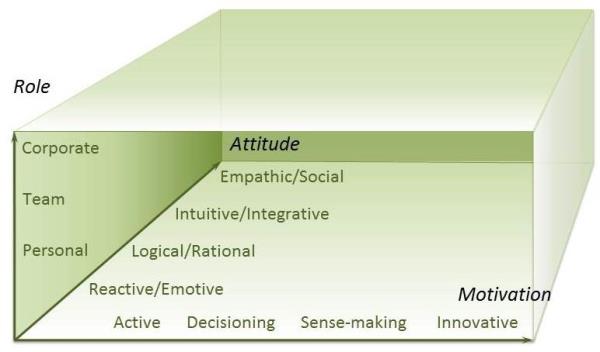
How Do You Make Decisions? (Part 4 of 4)
We need a new model of decision making to handle the real-world elements of our processes.
- By Barry Devlin
- June 3, 2016
We saw in Part 3 of this series that real human decision making is complicated by the unavoidable existence of "pre-rational" behaviors and that current BI approaches ignore this reality entirely. We need a new model that takes into account other aspects of the human condition: intent, emotion, and gut feel. It must also reference the fact that business is a social enterprise, which means that personal behaviors are modulated by inter-personal and organizational considerations.
In my book, Business unIntelligence: Insight and Innovation beyond Analytics and Big Data, I developed a conceptual model for decision making support in today's world. This model consists of three "thinking spaces." Two of these are obvious and long-recognized: information and process. However, I also explicitly included a people space in the conceptual architecture, sitting atop the information and process spaces.
As seen in Figure 1, this space -- like the others -- is defined by three axes that define key characteristics that must be considered in the design of solutions or software tools. In this case, they describe characteristics of decision making as performed by people in organizations. The horizontal axes depict psychological characteristics of attitude and motivation; the vertical axis represents the social aspect of role.

Figure 1: The People Space
The dimension of attitude describes a spectrum of psychological states that take us beyond the purely rational, using the triune model of the brain described in Part 3. The fight-or-flight reptile brain and emotional, old mammalian brain are represented by the reactive/emotive area, indicating pre-rational or irrational behavior.
The third level, the neocortex, is represented by the other three areas: left-brain logical/rational thinking, including numerical and verbal skills; right-brain intuitive/integrative thinking, the basis of innovation; and the empathic/social area, responsible for personal identification, social skills, and empathy.
Each of these areas is amenable to technological support and enhancement. The near-exclusive focus of today's BI tools is on logical/rational decision making, with limited interest in intuitive/integrative and empathic/social aspects. The reactive/emotional area is almost entirely ignored, although advances in artificial intelligence -- affective computing for emotion recognition, for example -- show promise in supporting this area.
The axis of role is more familiar, expressing the social organization in which decision makers sit. In its simplest form, shown here, we see the hierarchy of personal, team and corporate work structures. Overlaid on this, of course, are the more flexible and adaptive structures demanded by today's digitalized enterprises.
Finally, the facet of motivation offers insight into why people do what they do.
Active motivation means exactly what it sounds like: it is the desire for immediate action. Decisioning (called decisive in Business unIntelligence) refers to wanting to carefully decide what to do. Sense-making is the desire to understand a situation, and it links to the monitoring and evaluation of an external world that might be described as complex-complicated in Kurtz and Snowden's "The New Dynamics of Strategy." Innovative relates to the drive for creative behavior, vital in modern digitalized businesses.
Each intersection point of the axes describes a pursuit -- given a goal that a person or group seeks to achieve, this is a mental concept combining how the person approaches it (attitude), what drives the person to seek the goal (motivation), and the person's role in the organization.
For example, in order to tackle a difficult marketing situation, we may need to build an innovative team that works in an intuitive/integrative manner. We choose individuals with these psychological characteristics. However, in order to actually produce results, we may appoint a team leader with a combination of active motivation and empathic/social attitude. We will also need some logical/rational attitude to get the results documented.
It is through these main human and team pursuits that we can define and link to a set of useful business processes and finally understand the information resources required.
What is described here is a first-cut, conceptual-level architecture that explores how human decision making in all its aspects can be understood. Further design will be required to take this to a logical, functional level and BI tool vendors must step up to implement it in their products.
It seems likely that this will occur relatively quickly through advances in the application of artificial intelligence to all aspects of human behavior and interaction, as explored previously in my series "Where is cognitive decision making in BI?" For example, IBM has begun to discuss decision making support using cognitive computing via Watson.
A word of warning is appropriate, however. Our prior view of business decision making as fully rational allowed us to focus on the business data specific to a particular incident, process, or set of activities. Such data is largely factual and mainly impersonal. As we've moved toward predictive analytics, we have begun to gather and use larger volumes of personal data about customers, probing their detailed behaviors and opinions, and thus raising issues of privacy and ethics.
These issues become more acute as we enquire into the underlying motivations and intentions of people, both customers and (more likely) employees, in the pre-rational phase of decision making. Affective computing software can already be used to detect basic emotional reactions from facial expressions or conversational tones. From there, we can envision interpreting intent on the part of decision makers. For example, is this person's position on a particular solution based on personal animosity toward its proposer or driven by genuine concern for the good of the business?
Such approaches offer far greater insight into the decision-making ethos of the organization and its members. However, they also risk exposing of employees' personal histories and underlying psyches. An atmosphere of mistrust can easily be created. New HR policies and practices will be needed to deal with such situations, and understanding the cost/benefit balance is a vital first step.
About the Author
Dr. Barry Devlin is among the foremost authorities on business insight and one of the founders of data warehousing in 1988. With over 40 years of IT experience, including 20 years with IBM as a Distinguished Engineer, he is a widely respected analyst, consultant, lecturer, and author of “Data Warehouse -- from Architecture to Implementation" and "Business unIntelligence--Insight and Innovation beyond Analytics and Big Data" as well as numerous white papers. As founder and principal of 9sight Consulting, Devlin develops new architectural models and provides international, strategic thought leadership from Cornwall. His latest book, "Cloud Data Warehousing, Volume I: Architecting Data Warehouse, Lakehouse, Mesh, and Fabric," is now available.